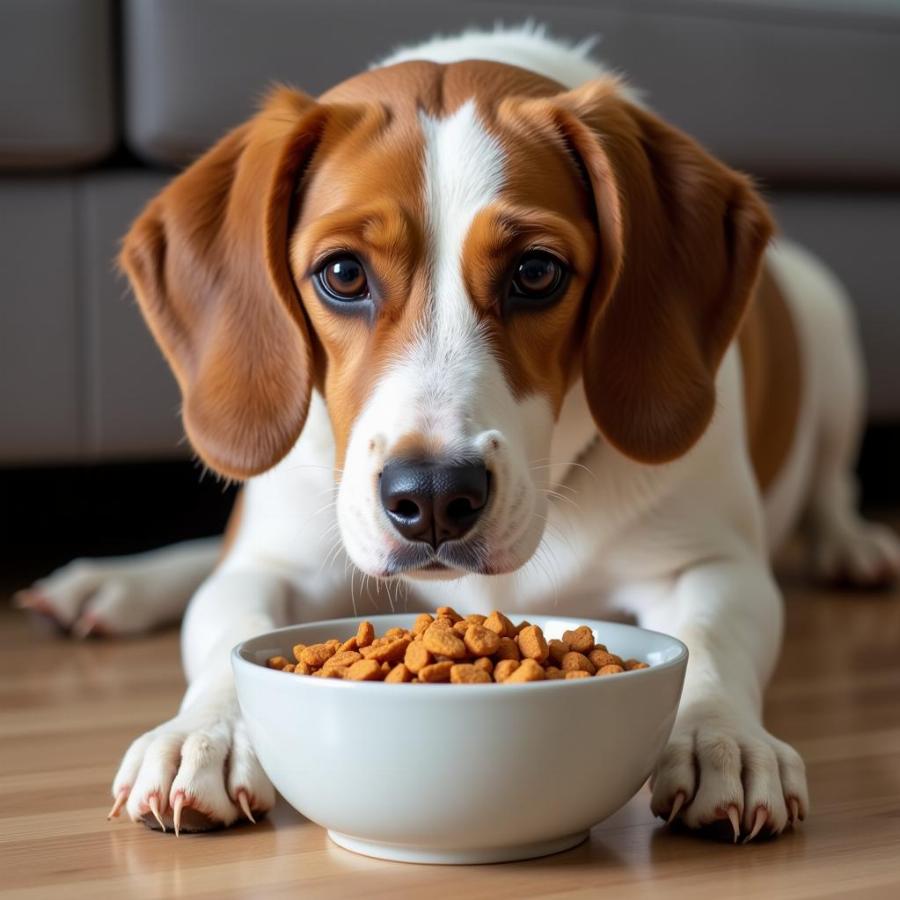Is your furry friend turning their nose up at kibble but happily gobbling down any other treat in sight? This selective appetite can be frustrating for pet parents, but don’t worry, you’re not alone. This comprehensive guide will explore the common reasons behind why your dog won’t eat kibble but devours other foods and offer practical solutions to help you overcome this picky eating habit.
Understanding the Picky Eater: Why Your Dog Prefers Other Foods Over Kibble
Dogs, like humans, have individual preferences, and what appeals to one dog may not entice another. Let’s delve into some possible explanations for your dog’s selective eating:
1. Kibble Boredom: The Monotony Factor
Imagine eating the same meal day after day – you’d probably get bored too! Dogs can experience the same monotony with their kibble, especially if it’s been a staple in their diet for a long time.
2. The Allure of Flavor and Variety: Tempting Treats vs. Bland Kibble
Let’s face it, kibble often lacks the enticing aroma and flavor of human food or tasty treats. Dogs have a strong sense of smell, and the blandness of kibble may not be as appealing as the savory goodness of other options.
3. Underlying Medical Conditions: When Picky Eating Signals a Problem
In some cases, a sudden disinterest in kibble could indicate an underlying medical issue. Dental problems, digestive upset, or even a recent vaccination can affect your dog’s appetite and make them hesitant to eat their usual food.
 Dog Refusing Kibble
Dog Refusing Kibble
4. Behavioral Reasons: Is Your Dog Holding Out for Something Better?
Dogs are masters of manipulation, and some clever canines learn that by refusing kibble, they might just get rewarded with something tastier. If you’ve given in to your dog’s picky eating habits in the past, they may be more likely to repeat the behavior.
How to Encourage Your Dog to Eat Kibble: Tips and Tricks for Picky Eaters
Now that you have a better understanding of why your dog might be snubbing their kibble, let’s explore some practical strategies to entice them back to their bowl:
1. Rule Out Medical Concerns: A Visit to the Vet is Key
Before implementing any dietary changes, it’s crucial to consult your veterinarian. They can assess your dog’s overall health, rule out any underlying medical conditions, and offer tailored advice based on your dog’s specific needs.
2. Spice Up the Kibble: Making Mealtime More Appealing
- Add Warm Water or Low-Sodium Broth: Enhance the aroma and flavor of the kibble by adding a splash of warm water or low-sodium broth.
- Mix in Wet Food: Combine a small amount of wet food with the kibble to create a more enticing texture and taste.
- Incorporate Healthy Toppers: Sprinkle in dog-friendly toppers like cooked chicken, fish, or vegetables for added flavor and nutrition.
3. Establish a Consistent Feeding Routine: Setting Mealtime Boundaries
- Feed at Regular Times: Offer meals at the same time each day to establish a predictable routine.
- Limit Treat Intake: Reduce the number of treats given throughout the day to prevent your dog from filling up on snacks.
- Remove Uneaten Food After 15-20 Minutes: If your dog doesn’t finish their kibble within a reasonable time frame, take the bowl away until their next scheduled meal.
4. Gradual Transition to New Kibble: Avoiding Digestive Upset
If you suspect kibble boredom, try gradually transitioning to a new brand or flavor. Start by mixing a small amount of the new kibble with the old, gradually increasing the ratio of new kibble over several days to minimize digestive upset.
5. Make Mealtime Fun: Positive Reinforcement Goes a Long Way
- Interactive Feeding Toys: Engage your dog’s natural foraging instincts with puzzle feeders or interactive toys that dispense kibble as they play.
- Praise and Rewards: Offer positive reinforcement, such as verbal praise or a gentle pat, when your dog shows interest in their kibble.
Don’t Give Up on Kibble Just Yet!
Remember, patience and consistency are key when dealing with a picky eater. By following these tips, you can encourage your dog to develop a taste for kibble and ensure they’re getting the balanced nutrition they need to thrive.
FAQs: Addressing Common Concerns About Picky Eaters
Q1: Is it okay to let my dog graze on kibble throughout the day?
A: While free-feeding might seem convenient, it’s generally not recommended. Establishing a structured mealtime routine helps regulate your dog’s digestion, prevents overeating, and makes it easier to monitor their food intake.
Q2: Can I add human food to my dog’s kibble?
A: While some human foods are safe for dogs, it’s essential to consult your veterinarian before adding anything to their diet. Some foods, like grapes and onions, can be toxic to dogs.
Q3: What if my dog still refuses to eat kibble after trying these tips?
A: If your dog continues to refuse kibble despite your best efforts, don’t hesitate to reach out to your veterinarian or a certified canine nutritionist for further guidance.
Need More Help With Your Picky Eater?
For personalized advice and support on addressing your dog’s nutritional needs, don’t hesitate to contact us at Beaut Dogs. We’re here to help you navigate the world of dog ownership and ensure your furry companion lives a happy, healthy life. When you need assistance, please reach out to us at Email: [email protected] to get detailed and accurate answers from Beaut Dogs.
Beaut Dogs is your go-to resource for all things dog-related, offering reliable, helpful, and in-depth information about the canine world. Visit our website at https://beautdogs.com today to explore the wonderful world of dog breeds and discover how to best care for them!